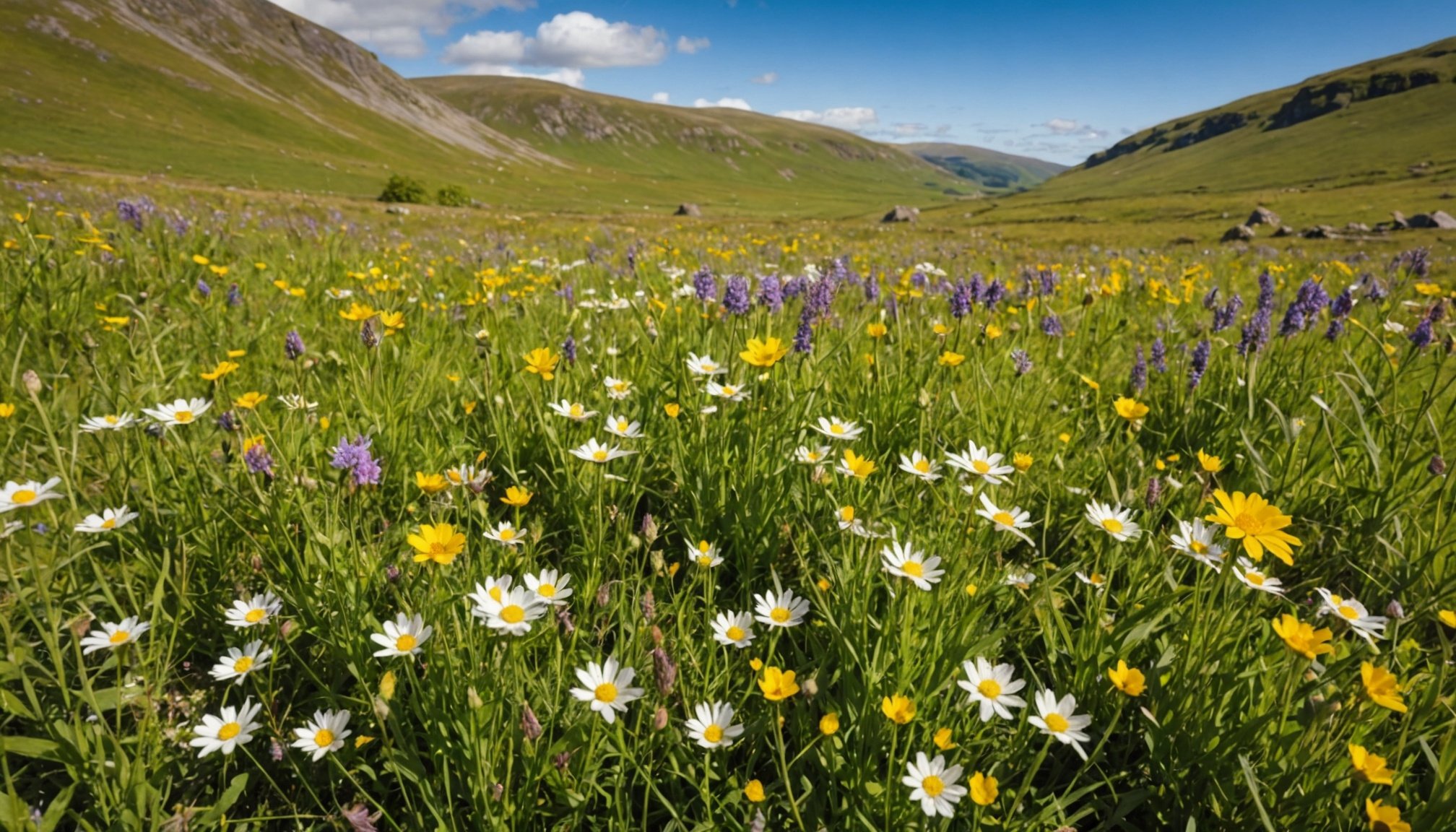Overview of Spring Camping in the UK
Spring Camping in the UK presents a unique opportunity to witness the vibrant rebirth of nature, a time cherished by nature enthusiasts. This season transforms the landscapes across the nation, revealing diverse ecosystems that boast a spectacular array of wildflowers. As the weather warms, fields and forests become canvases painted with colourful blooms, providing breathtaking scenery for campers.
Each region offers a distinct collection of flora due to its unique climate and geography. From the Scottish Highlands to the rolling hills of Wales, the UK wildflower experiences are varied and enriching. These environments are not just habitats for flowers but also for other wildlife, making spring an exhilarating time for observation and discovery.
Also read : Green Camping Essentials: Expert Tips for Safe Biodegradable Soap Use at UK Campsites
Camping during this vibrant season necessitates a strong commitment to responsible practices. The beauty of the landscapes can only be preserved through the mindful engagement of visitors. Campers must respect local ecosystems by following established trails, minimising waste, and adhering to designated camping areas. This approach ensures the enchanting beauty of spring camping remains for future generations, allowing more people to enjoy the rich tapestry of life that the UK offers during this season.
Top Locations for Wildflower Camping
Springtime in the UK, a time of renewal and growth, offers numerous wildflower camping locations that captivate the senses. The vibrant rebirth of nature across the country’s diverse ecosystems makes for an unforgettable camping experience.
Also to see : Explore Premier UK Campsites Offering Seamless National Trail Access
National Parks
National parks in the UK stand out as prime spots for spring camping. The Lake District, with its stunning backdrop of mountains and lakes, hosts an array of colourful blooms. Similarly, Peak District offers vast expanses filled with wildflowers. These parks are designed to cater to campers with essential facilities such as toilets, water taps, and marked trails. Popular wildflower hotspots include Windermere and Mam Tor.
Nature Reserves
The UK nature reserves are also rich havens for discovering wildflowers. Reserves like the one at RSPB Minsmere are renowned for their unique flora and engaging wildlife. When visiting, it’s crucial to adhere to guidelines like maintaining trail integrity and protecting habitats, ensuring a sustainable interaction with the environment.
Coastal Areas
Coastal regions, often overlooked, provide stunning wildflower vistas. Areas like the Jurassic Coast are home to fascinating wildflower species such as sea campion. While camping along these picturesque seaside spots, it’s important to practice eco-friendly habits to preserve the coast’s natural beauty and biodiversity.
Wildflower Identification Tips
Identifying wildflowers during your spring camping adventures can enhance your appreciation of the UK’s diverse ecosystems. Leveraging key resources is paramount to becoming proficient. Mobile apps like PlantNet and Flora Incognita are invaluable tools. These apps provide detailed identification, mapping, and explanations, leveraging their vast databases to deliver precise results. Couple this with traditional field guides such as the Collins Wild Flower Guide, which offers exquisite illustrations and descriptions, to confirm your findings.
When are the best times for wildflower spotting? Generally, spring presents the optimal opportunity. However, it’s crucial to acknowledge that seasonal variations and climate influence blooming. For instance, a mild spring can herald early blossoms, while a cold snap might delay them.
Make your discovery engaging by contextually understanding each plant’s role in its habitat—knowledge found within these resources that can vastly enrich your camping experience. Balancing technology with tangible guides not only aids identification but also builds a deeper connection with nature, enabling better understanding and appreciation.
Essential Gear for Spring Camping
Spring camping requires the right gear to ensure both comfort and safety in the UK’s unpredictable weather. Choosing the perfect camping gear is essential for a successful trip.
Shelter and Sleeping Gear
Selecting an appropriate tent is crucial. Opt for a three-season tent to withstand spring’s varying temperatures and occasional rain showers. Tents with a durable rainfly and robust poles are recommended to handle the unpredictable elements. A sleeping bag suited for temperatures around 0-10°C paired with an insulated sleeping mat will provide comfort and warmth during chilly nights.
To tackle the dampness often encountered, waterproofing essentials such as ground tarps and seam sealers are indispensable. These not only protect your equipment but also enhance your camping experience.
Wildflower Exploration Gear
For those eager to explore and appreciate the UK’s wildflowers, essential tools include magnifying glasses for close inspections and light-weight field notebooks for documentation. Binoculars and cameras serve double duty for both observing and capturing the picturesque landscapes. Packing health essentials like sunscreen to shield against UV rays and sufficient water supply ensures a safe and pleasurable adventure. Bridging exploration and preparedness allows for an enriching and secure outing in nature’s vibrant tapestry.
Best Times to Experience Wildflowers
The occurrence of wildflower blooms in the UK varies with the seasons, making understanding peak blooming times essential for enthusiasts. Spring flowers generally start to flourish between March and May, with species like bluebells and daffodils stealing the spotlight in early April. However, seasonal events such as early spring festivals often celebrate these blossoms, offering a guided experience.
Weather patterns significantly influence when wildflowers bloom. A warm winter may lead to earlier blooms while unexpected late frosts can delay flowering. Hence, monitoring weather forecasts can be incredibly beneficial for planning a camping trip dedicated to wildflower exploration. Areas with mild and consistent temperatures, such as the south of England, tend to see earlier blooms, whereas northern locations might experience a subtle delay.
To maximise your wildflower experience, consider visiting during regional spring celebrations when the landscapes are at their most colourful. These festivals not only enhance your engagement with nature but also provide a cultural context to the natural beauty surrounding you. Embracing local customs and participating in these events can foster a deeper appreciation for the UK’s vibrant floral ecosystems.
Activities and Engagement with Nature
Spring camping in the UK offers numerous opportunities for outdoor activities that deepen engagement with nature. It allows campers to connect with the environment while enjoying the splendour of blooming landscapes.
Guided Wildflower Walks
Participating in guided wildflower walks can significantly enhance your camping experience. Many organizations offer these educational tours, providing a wealth of knowledge about local flora. Expect to learn about the unique ecosystems and the significance of various plant species during these hikes. These walks are ideal for both beginners and seasoned nature enthusiasts seeking a deeper understanding of the UK’s diverse ecosystems.
Photography and Art
Capturing the vibrant colours of wildflowers through photography not only immortalises their beauty but also promotes artistic inspiration. Utilize cameras to explore different perspectives and create captivating images. Art-inspired activities, such as drawing or painting during camping trips, help cultivate creativity and appreciation for nature’s intricate details. Community initiatives often encourage sharing these creations, fostering a collective celebration of nature.
Conservation Activities
Engaging in conservation activities allows campers to give back to the environment. Volunteering for local projects can have meaningful impacts on biodiversity. By practicing eco-friendly camping habits, individuals contribute positively to the ecosystems they admire—ensuring their preservation for future enjoyment.











